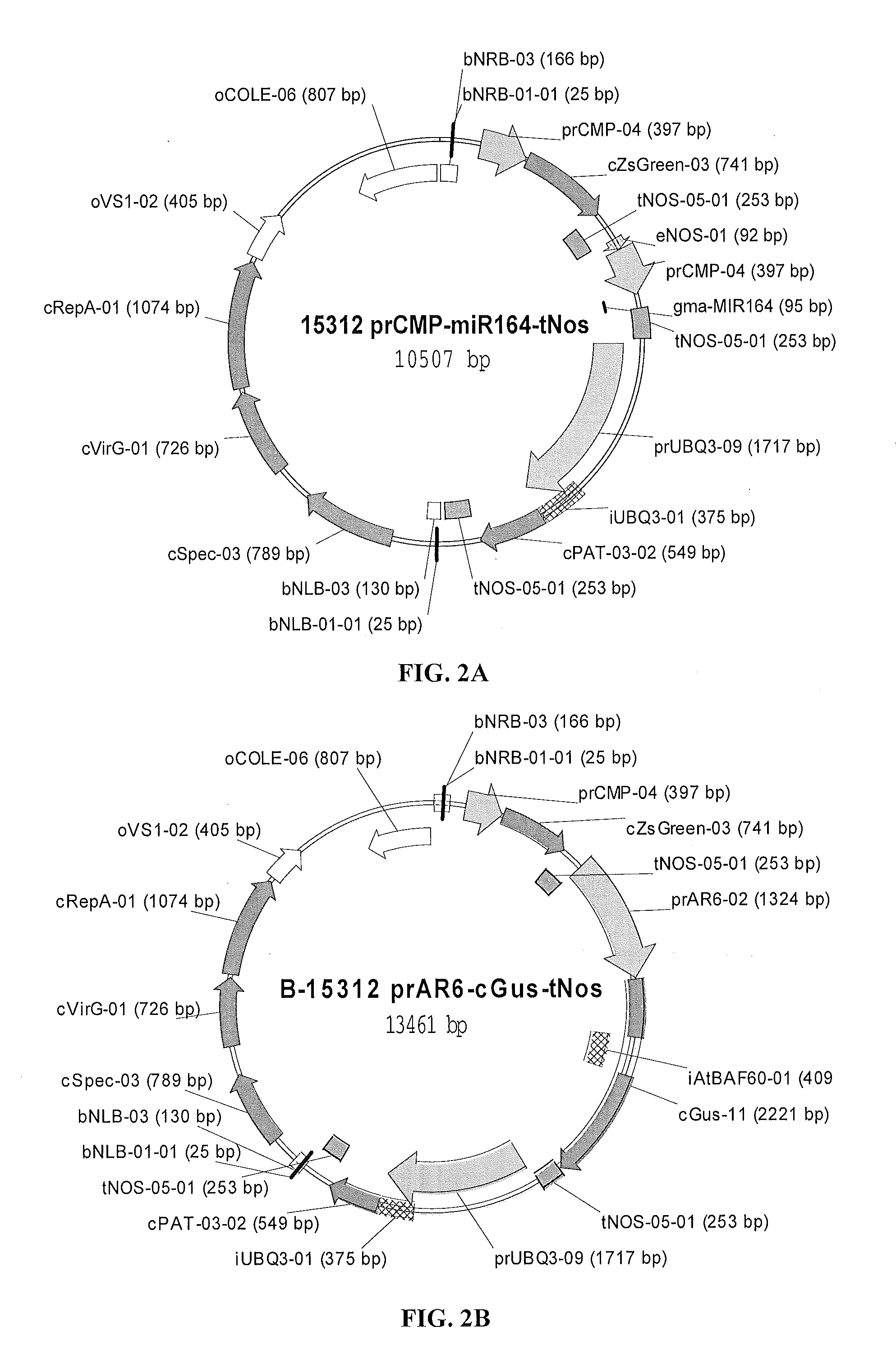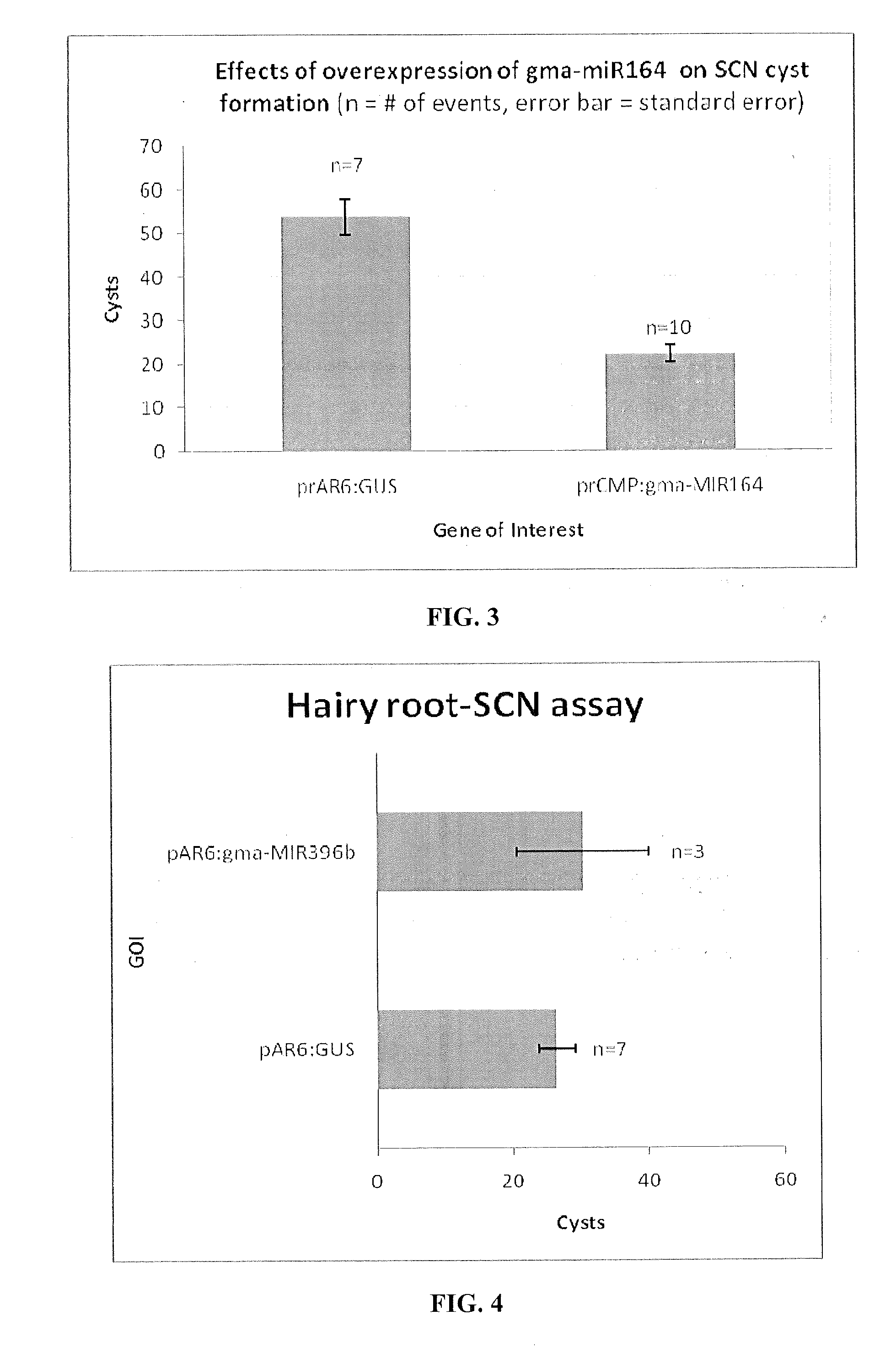Overexpression of Plant Mirnas for Parasite Control
a technology of mirnas and mirnas, which is applied in the field of parasite control of plant mirnas, can solve the problems of wilting of plants, inability to eradicate plants using known methods, and billions of dollars in crop losses world-wide, and achieve the effects of reducing the formation of soybean cyst nematode cysts, and reducing the formation of soybean cyst nematode cys
- Summary
- Abstract
- Description
- Claims
- Application Information
AI Technical Summary
Benefits of technology
Problems solved by technology
Method used
Image
Examples
example 1
Preparation of Expression Cassettes
[0138]miR164 (gma-miR164; FIG. 1; SEQ ID NO:1) was cloned into a prCMP:MIR164:tNOS expression cassette. The expression cassette with the miR164 was then cloned into a binary vector to create the vector pKS033 (a.k.a. 15312 prCMP-MIR164-tNOS; shown in FIG. 2).
[0139]The pKS033 vector was then transformed into Agrobacterium rhizogenes Strain K599. As control, binary vector pKS001 (a.k.a. B-15312-prAR6-cGUS-tNOS) with prAR6:GUS:tNOS cassette was transformed into the A. rhizogenes K599 strain. In the case of the control, the expression cassette does not include miR164.
example 2
Induction and Selection of Transgenic Soybean Hairy Root Events Harboring The prCMP:MIR164:tNOS Expression Cassette and the prAR6:GUS:tNOS Cassette
[0140]Narayanan et al. (Crop Science 39:1680-1686 (1999)) indicated that SCN resistance phenotypes in the whole plant were preserved in transgenic hairy roots, therefore transgenic hairy root system is useful for evaluating candidate SCN resistance genes. Accordingly, the soybean hairy root system was used to evaluate resistance to SCN. Soybean cultivar Williams 82 was used as the gerplasm for the hairy root transformation. Seeds of soybean seeds were germinated on 1% agar containing 0.5% sucrose in petri dishes at 27° C. for 5 days. The cotyledons were then cut off the seedlings, and the wounded surface was inoculated with cultures of the Agrobacterium carrying pKS033 and pKS001. The cotyledons were placed on 1% agar for 6 days and then transferred onto selection media. In about two weeks, independent transgenic hair root events induced fro
example 3
Evaluation of Cyst Formation in Soybean Hairy Root System
[0141]Evaluation in Hairy Roots Comprising the prCMP:MIR164:tNOS Expression Cassette.
[0142]Two weeks after transfer onto the culture plates, the transformed hairy roots were inoculated with surface-sterilized J2 stage soybean cyst nematodes (SCN J2) and the roots were grown in darkness at 27° C., which allowed cyst formation on the hairy root events. One month after nematode inoculation, the number of cysts was determined for both the roots comprising the prCMP:MIR164:tNOS expression cassette and the roots comprising the prAR6:GUS:tNOS cassette. As shown in FIG. 3, the average cyst number in the roots overexpressing miR164 was found to be significantly lower than that for the control plants that express the GUS gene (i.e., no miR164) (p<0.01), based on ANOVA single factor analysis.
Evaluation in Hairy Roots Comprising the prAR6:gma-MIR396b Expression Cassette
[0143]In a similar experiment, another soybean miRNA, gma-miR396a, was ov
PUM
| Property | Measurement | Unit |
|---|---|---|
| Electrical resistance | aaaaa | aaaaa |
Abstract
Description
Claims
Application Information
 Login to view more
Login to view more - R&D Engineer
- R&D Manager
- IP Professional
- Industry Leading Data Capabilities
- Powerful AI technology
- Patent DNA Extraction
Browse by: Latest US Patents, China's latest patents, Technical Efficacy Thesaurus, Application Domain, Technology Topic.
© 2024 PatSnap. All rights reserved.Legal|Privacy policy|Modern Slavery Act Transparency Statement|Sitemap



